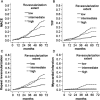The relationship between revascularization extent and the long-term prognosis of patients with stable angina pectoris and three-vessel disease treated by percutaneous coronary intervention in the era of drug-eluting stents
- PMID: 25123798
- PMCID: PMC6649467
- DOI: 10.1002/clc.22309
The relationship between revascularization extent and the long-term prognosis of patients with stable angina pectoris and three-vessel disease treated by percutaneous coronary intervention in the era of drug-eluting stents
Abstract
Background: The effects of revascularization extent (RE) on the long-term prognosis of patients with stable angina pectoris and 3-vessel disease who underwent percutaneous coronary intervention were unknown.
Hypothesis: The study was aimed at evaluating whether there was an effect of RE on patients presenting with stable angina pectoris and 3-vessel disease.
Methods: RE, which was calculated by baseline SYNTAX (Synergy Between Percutaneous Coronary Intervention With Taxus and Cardiac Surgery) score minus residue SYNTAX score divided by baseline SYNTAX score, was initially used in our study. Five hundred fifty-eight patients presenting with stable angina pectoris and 3-vessel disease were assigned to and compared among tertiles according to RE and clinical outcomes. The primary end point was the major adverse cardiovascular event (MACE), a composite of cardiac death, nonfatal myocardial infarction (MI), and any repeat revascularization.
Results: The median follow-up period was 56.9 months (interquartile range, 52.1-63.6). The incidence of MACE increased significantly as RE increased (13.3%, 31.4%, and 44.1%, log-rank P < 0.001). The same tendency was observed in occurrences of target-vessel failure (TVF) (a composite of cardiac death, MI, or target-vessel revascularization) (8.8%, 20.3%, and 28.4%, log-rank P < 0.001), repeat revascularization (11.8%, 26.2%, and 35.6%, log-rank P < 0.001), and MI (1.1%, 2.9%, and 12.6%, log-rank P < 0.001). Multivariate analysis confirmed the tendencies mentioned above.
Conclusions: For patients presenting with stable angina pectoris and 3-vessel disease, the increasing extent of revascularization resulted in a less favorable prognosis.
© 2014 Wiley Periodicals, Inc.
Figures


Similar articles
-
Prognostic significance of endothelial dysfunction in patients undergoing percutaneous coronary intervention in the era of drug-eluting stents.BMC Cardiovasc Disord. 2015 Sep 23;15:102. doi: 10.1186/s12872-015-0096-z. BMC Cardiovasc Disord. 2015. PMID: 26399321 Free PMC article.
-
5-year results of a randomized comparison of XIENCE V everolimus-eluting and TAXUS paclitaxel-eluting stents: final results from the SPIRIT III trial (clinical evaluation of the XIENCE V everolimus eluting coronary stent system in the treatment of patients with de novo native coronary artery lesions).JACC Cardiovasc Interv. 2013 Dec;6(12):1263-6. doi: 10.1016/j.jcin.2013.07.009. Epub 2013 Nov 13. JACC Cardiovasc Interv. 2013. PMID: 24239202 Clinical Trial.
-
The anatomic- and clinical-based NERS (new risk stratification) score II to predict clinical outcomes after stenting unprotected left main coronary artery disease: results from a multicenter, prospective, registry study.JACC Cardiovasc Interv. 2013 Dec;6(12):1233-41. doi: 10.1016/j.jcin.2013.08.006. Epub 2013 Nov 13. JACC Cardiovasc Interv. 2013. PMID: 24239199
-
Scaffold Thrombosis After Percutaneous Coronary Intervention With ABSORB Bioresorbable Vascular Scaffold: A Systematic Review and Meta-Analysis.JACC Cardiovasc Interv. 2016 Jan 11;9(1):12-24. doi: 10.1016/j.jcin.2015.09.024. JACC Cardiovasc Interv. 2016. PMID: 26762906 Review.
-
Percutaneous coronary intervention in patients with diabetes: current concepts and future directions.J Diabetes Sci Technol. 2014 May;8(3):581-9. doi: 10.1177/1932296813517058. Epub 2014 Feb 5. J Diabetes Sci Technol. 2014. PMID: 24876623 Free PMC article. Review.
Cited by
-
Late percutaneous coronary intervention prevents left ventricular remodeling and improves clinical outcomes in patients with ST-elevation myocardial infarction.Clin Cardiol. 2015 Feb;38(2):82-91. doi: 10.1002/clc.22356. Epub 2015 Feb 3. Clin Cardiol. 2015. PMID: 25649130 Free PMC article.
References
-
- Rogers WJ, Bourassa MG, Andrews TC, et al. Asymptomatic Cardiac Ischemia Pilot (ACIP) study: outcome at 1 year for patients with asymptomatic cardiac ischemia randomized to medical therapy or revascularization. The ACIP Investigators. J Am Coll Cardiol. 1995;26:594–605. - PubMed
-
- Hannan EL, Racz M, Holmes DR, et al. Impact of completeness of percutaneous coronary intervention revascularization on long‐term outcomes in the stent era. Circulation. 2006;113:2406–2412. - PubMed
-
- Hannan EL, Wu C, Walford G, et al. Incomplete revascularization in the era of drug‐eluting stents: impact on adverse outcomes. JACC Cardiovasc Interv. 2009;2:17–25. - PubMed
-
- Kim YH, Park DW, Lee JY, et al. Impact of angiographic complete revascularization after drug‐eluting stent implantation or coronary artery bypass graft surgery for multivessel coronary artery disease. Circulation. 2011;123:2373–2381. - PubMed
-
- van den Brand MJ, Rensing BJ, Morel MA, et al. The effect of completeness of revascularization on event‐free survival at one year in the ARTS trial. J Am Coll Cardiol. 2002;39:559–564. - PubMed
MeSH terms
LinkOut - more resources
Full Text Sources
Other Literature Sources
Medical

